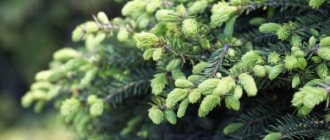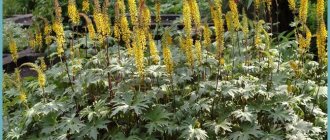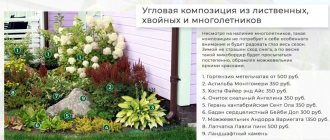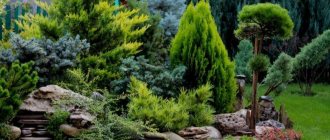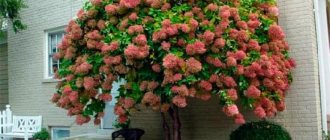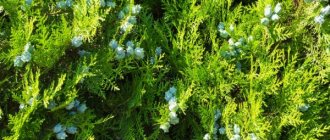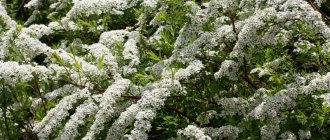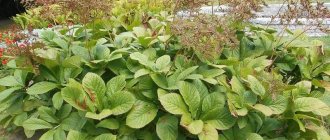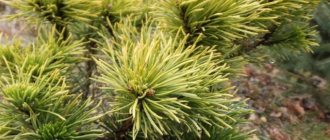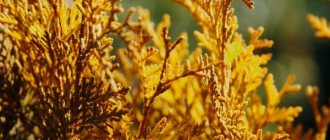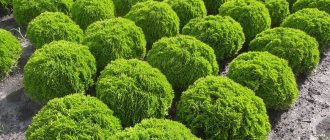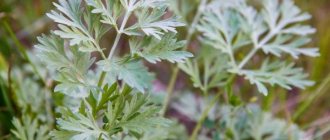Not every gardener knows such a word as rutarium. But in fact, this unique composition is very common in modern landscape design. When literally translated from English, “root” is a root; accordingly, rutarium is a composition of branches, snags, roots and even stumps. Previously, similar elements were included in the front garden, flower garden or rock garden to make them unusual. Today, from the simplest roots and branches of trees, you can create a rutarium with your own hands. Just a little desire, imagination and fantastic compositions will transform the entire appearance of the garden plot.
Rutaria
Rutarium can be the main component of design
When deciding to make an original composition on your site, you should take into account several nuances and tips. Thus, a rutary can act as an independent unit of landscape design, and be an auxiliary element in a complex composition. It is worth noting that in the first case, you will need to pay a lot of attention and involve professionals, and in the second, everything is quite simple, and any novice gardener can cope with the task.
Or auxiliary
The many advantages of rutaria should also include:
- creativity;
- ease of creation;
- availability of all materials;
- ease of care;
- guaranteed success.
There are several types of rutarii.
Natural rutarium
Natural. This is the main type of rutaria. You can create it at the dacha, including in the composition those materials that are on the territory. For example, an old tree that has been cut down can become the basis for a future root garden. Small flowers that are planted directly into the stump will look quite original. Stone and moss should be included as an addition, they are also easy to obtain.
Stumps instead of flowerpots
Protozoa. The composition includes exclusively driftwood and stumps. They will become a harmonious addition to an alpine hill or will find a place for themselves in a secluded corner of the garden.
Stump figures
Decorative. The most complex type, since its development and creation necessarily includes figures made of wood and various plants. Skilled craftsmen make fairy-tale characters and animals from unsightly driftwood. This will certainly require at least the advice of a professional, but as a result you can get something more than a simple set of roots.
Note!
Rutary is a universal element of landscape design, where there are no restrictions for creativity and imagination.
Materials
As mentioned above, a wide variety of driftwood, logs, roots, decayed parts and much more can serve as the main material. The following will serve as an addition and decoration:
- pebbles;
- live plants;
- moss;
- wild bushes;
- pieces of lawn.
Particular attention should be paid to the correct selection of plants. It is worth considering only low-growing and creeping flowers, as well as ferns and mosses. Among the large-sized composition, berry bushes can also be successfully placed: lingonberries, blueberries and strawberries.
The choice of material must be approached with all responsibility, since it must first of all be of high quality, and secondly, be decorative. Only in this case will the created rutarium delight its owners for several years in a row.
To complement the composition, not only sculptures, but also simple bottles with pots can often be used.
The material must not only be selected, but also properly prepared. Among the simplest and most elementary processes are opening with varnish, sawing and joining with an element. But, it is best to follow a simple algorithm of actions:
- Cleaning the collected material from debris using brushes or a broom. If necessary, certain areas are washed.
- Heat treatment with boiling water and inspection for the presence of insects, their removal.
- Treating wooden elements with an antiseptic. It is best to use a hand sprayer so that the composition gets into all hard-to-reach places.
- Painting or varnishing. It is worth noting here that driftwood may lose its naturalness.
If you want to get a rich picture with several colors, you should paint some elements in different colors. Drawing faces or patterns would also be appropriate here. Stones will also transform the composition, giving it some kind of completeness. Even old shoes, preferably wooden ones, will look impressive and original in the rutaria. You can plant flowers inside it.
It is recommended to treat not only with antiseptics, but also with special protective compounds or impregnations.
Basic rules for creating a rutaria
It is impossible to say that there are strict rules when creating a composition, since it is impossible to plan exactly the final result. You should only adhere to the basic rule: the rutarium should, in its entire appearance, resemble a corner of wild nature. However, it is recommended to consider a few tips:
- Clear planning. It is best to record all your thoughts and wishes on paper or use special computer programs to develop landscape design.
- As mentioned above, rutarium can consist entirely of inanimate elements of wood or can be combined well with living flowers.
- When selecting roots and bark, special attention should be paid to those elements that resemble a fairy-tale character or figure.
- The placement of the composition has no restrictions. This could be a veranda, a front garden in front of the house, a garden, an artificial pond and other options.
Note!
It is impossible to create two identical rutaria, since nature is unique.
Determining the place
Choose a good place
The great popularity of rutarii is due to the fact that with their help you can transform and radically change the appearance of even the most problematic area in the garden area. If there is an original place that is not suitable for creating a front garden with perennial plants, then the root garden is the right place.
Another good option is a shady area under a spreading canopy of trees. When looking at your site, pay attention to the corners of the fence. Most likely, there is nothing here, since flowers will not grow due to the shadow. That is why the rutary will look win-win.
Note!
Rutarium is suitable for decorating a blind fence.
A guide to designing a rutaria at your dacha with your own hands
Creativity in the design of housing and garden plots has long been in vogue. Let's talk about an interesting way to decorate a garden, namely how to make a rutarium with your own hands.
Very often, rutaria are arranged in those parts of the garden where, for some reason, it is impossible to grow flowers.
Perhaps for some the word rutary will seem strange and unusual. But rutaria are landscape compositions made by hand using materials such as tree roots and trunks, various driftwood, stones and ornamental plants, planted after the main elements have been placed.
Creativity lies in the proper arrangement of all the materials you have in the garden, decorating them with flowers and creating a harmonious composition.
Flowers and climbing plants are one of the most important additions to rutaria. With the help of this greenery, you can create not only a unique garden, but also change colors and shapes, every now and then moving flowers from place to place (if they are planted in convenient portable pots).
Sometimes instead of the word “rutary” the expression “garden of roots” is used.
What is the peculiarity of this particular design composition at the dacha:
- Lots of places to bring it to life. If you want to make a composition at your dacha, then not only a huge yard, but also a tiny veranda or terrace will suit you.
- The lowest possible price for the composition. Provided that you extract the material yourself, the cost is practically zero.
- The ability to experiment unlimitedly with the landscape of the composition, constantly changing it.
- The quirkiness and uniqueness of the composition will add additional creativity to the garden.
Return to contents
Preparation
Collect stumps and snags
To know how to make a beautiful rutarium on your site, you need to start from the very beginning. So, the basis of the composition are ordinary branches and stumps, which should not be thrown away or burned. Store them in your shed and garage so you can use them later. If there is not enough material on the territory, you can go for a walk in the forest. There will certainly be an interesting snag or piece of bark here.
The basis of the composition can be an ordinary stump
It is very important to remember that wood is a fragile material, in addition, it will be influenced by various factors:
- the tree will begin to rot from excess moisture and direct contact with the ground;
- due to the high heat in the summer, driftwood will also dry out;
- vulnerable to insects.
Preference should be given to hard wood. A good option would be to choose driftwood and logs that were found on the beach of a river or lake.
Suitable driftwood found on river banks
It is worth paying attention to the preparation of the material, that is, wooden elements:
- remove bark from all elements so as not to attract bark beetles;
- treat the wood with special antiseptics that will protect it from the effects of precipitation;
- remove existing larvae and bacteria using boiling water and then dry;
- To extend the life of the rutaria, it is best to cover the elements with a layer of varnish or machine oil, which will also protect the wood from moisture and soil.
Remove bark and process
Note!
Among the tree varieties most susceptible to rot are aspen, poplar and birch, so it is better to minimize their presence in the tree.
Placement in landscape design
When the varieties have been considered, you can move on to the next stage - placement at the dacha, or rather, choosing the right place. In most cases, such a decorative area will look good in any placement, but there are still several most popular options:
- near the recreation area, the rutarium is represented in the form of guardians of the hearth and gnomes, who bring happiness;
- behind the hedge, preferably at the entrance to the territory of the dacha, bright plants, in particular flowers, will complement the composition;
- Large and shy compositions are placed in a distant corner, which become a reason for discussion and leave vivid impressions.
Here are some more recommendations for choosing a location:
- when supplementing the rutaria with figurines of gnomes or birds, it is best to place it in plain sight, that is, in a place that is most visible;
- natural or wild style will fit perfectly into the shady garden area;
- a set of branches of an original shape can serve as a fence for a flower garden;
- all found and selected wooden elements will be ideally placed around and on a stump that has not been uprooted from the ground;
- the garden of roots will find a place near a reservoir, both natural and artificial.
Make every effort to combine the rutaria with the style of the territory, as it should be unobtrusive and harmonious.
Composition design
When everything is prepared and planned, you can start arranging the elements. Stick to the plan you created. You should start with the largest elements - stumps and snags - which should take center stage. Bulky and tall elements must be securely fixed so that the wind cannot break the constructed composition.
Start with large elements
From large elements you can move on to medium ones, and then to the smallest ones. After everything is put in its place, evaluate the result. You can make adjustments if necessary. Follow the advice and wishes of those in your household, as well as your own intuitions. Only at the last stage can you start planting plants.
Note!
When planning to create a rutary, you must always remember that it belongs to the restrained style of landscape decor, which is characterized by Scandinavian rigor.
Fern
If you decide to include plants in the composition, then all selected plants should look like wild plants. It is worth abandoning tall and lush types, and give preference to:
- fern;
- moss;
- alpine herbs;
- daisies;
- begonias;
- petunias.
Almost all low-growing plants will fit harmoniously into a woody composition. Particular attention should be paid to the yaskolka, which designers quite often include in the compositions of rutaries. You can also place small decorative garden figures - mushrooms, snails, gnomes and animals.
Use low growing plants
Note!
The main attraction of landscape design is the illusion of untouched nature.
At the end of the article, I would like to remind you that rutaria, like any other landscape design composition, requires careful and special care. Despite all precautions and protection measures, some elements may begin to rot and deteriorate, so they should be replaced in a timely manner. Weeds may also appear among the plants, which will spoil the overall appearance - they must be removed.
